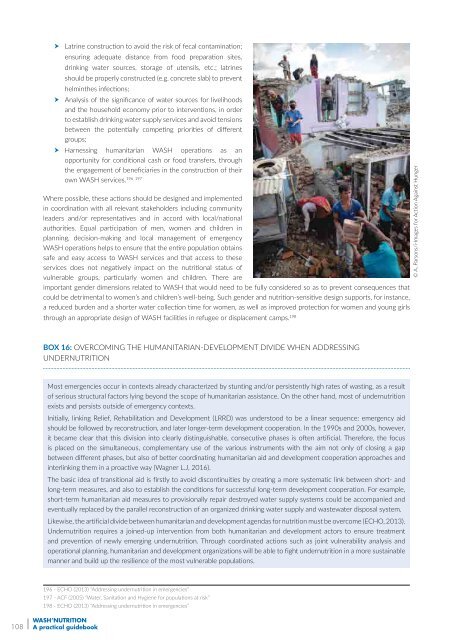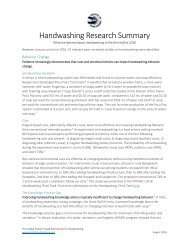WASH’ Nutrition
manuel_wash_nutrition_online
manuel_wash_nutrition_online
Create successful ePaper yourself
Turn your PDF publications into a flip-book with our unique Google optimized e-Paper software.
Latrine construction to avoid the risk of fecal contamination;<br />
ensuring adequate distance from food preparation sites,<br />
drinking water sources, storage of utensils, etc.; latrines<br />
should be properly constructed (e.g. concrete slab) to prevent<br />
helminthes infections;<br />
Analysis of the significance of water sources for livelihoods<br />
and the household economy prior to interventions, in order<br />
to establish drinking water supply services and avoid tensions<br />
between the potentially competing priorities of different<br />
groups;<br />
Harnessing humanitarian WASH operations as an<br />
opportunity for conditional cash or food transfers, through<br />
the engagement of beneficiaries in the construction of their<br />
196 197<br />
own WASH services.<br />
Where possible, these actions should be designed and implemented<br />
in coordination with all relevant stakeholders including community<br />
leaders and/or representatives and in accord with local/national<br />
authorities. Equal participation of men, women and children in<br />
planning, decision-making and local management of emergency<br />
WASH operations helps to ensure that the entire population obtains<br />
safe and easy access to WASH services and that access to these<br />
services does not negatively impact on the nutritional status of<br />
vulnerable groups, particularly women and children. There are<br />
important gender dimensions related to WASH that would need to be fully considered so as to prevent consequences that<br />
could be detrimental to women’s and children’s well-being. Such gender and nutrition-sensitive design supports, for instance,<br />
a reduced burden and a shorter water collection time for women, as well as improved protection for women and young girls<br />
through an appropriate design of WASH facilities in refugee or displacement camps. 198<br />
© A. Parsons/i-Images for Action Against Hunger<br />
BOX 16: Overcoming the humanitarian-development divide when addressing<br />
undernutrition<br />
Most emergencies occur in contexts already characterized by stunting and/or persistently high rates of wasting, as a result<br />
of serious structural factors lying beyond the scope of humanitarian assistance. On the other hand, most of undernutrition<br />
exists and persists outside of emergency contexts.<br />
Initially, linking Relief, Rehabilitation and Development (LRRD) was understood to be a linear sequence: emergency aid<br />
should be followed by reconstruction, and later longer-term development cooperation. In the 1990s and 2000s, however,<br />
it became clear that this division into clearly distinguishable, consecutive phases is often artificial. Therefore, the focus<br />
is placed on the simultaneous, complementary use of the various instruments with the aim not only of closing a gap<br />
between different phases, but also of better coordinating humanitarian aid and development cooperation approaches and<br />
interlinking them in a proactive way (Wagner L.J, 2016).<br />
The basic idea of transitional aid is firstly to avoid discontinuities by creating a more systematic link between short- and<br />
long-term measures, and also to establish the conditions for successful long-term development cooperation. For example,<br />
short-term humanitarian aid measures to provisionally repair destroyed water supply systems could be accompanied and<br />
eventually replaced by the parallel reconstruction of an organized drinking water supply and wastewater disposal system.<br />
Likewise, the artificial divide between humanitarian and development agendas for nutrition must be overcome (ECHO, 2013).<br />
Undernutrition requires a joined-up intervention from both humanitarian and development actors to ensure treatment<br />
and prevention of newly emerging undernutrition. Through coordinated actions such as joint vulnerability analysis and<br />
operational planning, humanitarian and development organizations will be able to fight undernutrition in a more sustainable<br />
manner and build up the resilience of the most vulnerable populations.<br />
196 - ECHO (2013) “Addressing undernutrition in emergencies”<br />
197 - ACF (2005) “Water, Sanitation and Hygiene for populations at risk”<br />
198 - ECHO (2013) “Addressing undernutrition in emergencies”<br />
108<br />
<strong>WASH’</strong><strong>Nutrition</strong><br />
A practical guidebook



